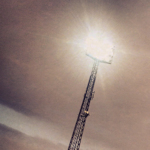
As long as you don’t expect world-class football, Vienna has a host of clubs happy to sell you an entrance ticket. But where do you get the best experience?
- Try Rapid Wien and Austria Wien for Bundesliga football and modern stadiums
- Try Wiener Sportclub and First Vienna FC for semi-professional football with friendly crowds and local flair
- See also:
Football in Vienna

(The new Rapid Vienna stadium)
OK, first a very quick overview of how the local football system works.
Skiing may be the number one sport in Austria, but football has a long tradition and decent support (especially in the cities). At one point, the Austrian national team was pretty much the best on the planet. Those were the Wunderteam years of the early 1930s.
Today’s domestic league suffers from the attractions of the German Bundesliga, the Premier League and elsewhere, which tend to drain the Austrian clubs and academies of all the top talent (and viewers).
League structure
- The top two tiers of football are national leagues: the Bundesliga and the Zweite Liga.
One team dominates the Bundesliga: 2013 was the last time Red Bull Salzburg were not champions. Other traditionally well-supported clubs are Rapid Vienna, Sturm Graz, LASK Linz and Austria Vienna.
- The third tier consists of three regional leagues
Clubs from Vienna play in Regionalliga Ost alongside representatives from two other provinces: Burgenland and Lower Austria.
- Tier 4 consists of separate leagues for each province
Since Vienna counts as a province in its own right, Tiers 4 and below are essentially city leagues populated mostly by clubs from within the capital’s borders. Tier 4 is called the Wiener Stadtliga in Vienna.
Each league normally has a lengthy winter break, since the Austrian climate often means proper winters with snow, ice and low temperatures.
Fan culture
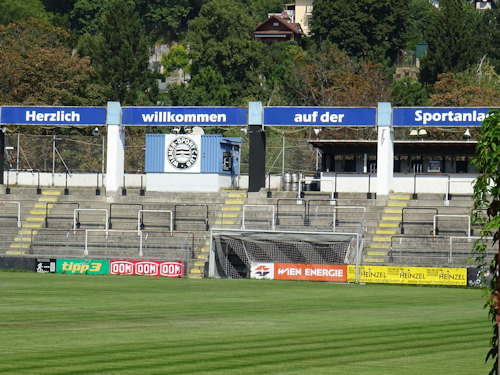
(The Cemetery Stand at Wiener Sportclub)
The typical stadium tradition among the top tier clubs is a little different to the British one.
Rather than respond mainly to what’s going on in the game, the hardcore fans (ultras) keep up a continuous cacophony of noise and colour intended to create an atmosphere of support for their team.
Of course, that atmosphere depends on the size of that hardcore group. And their efforts can have the opposite effect, should the ultras become disgruntled with the players or club. Nor are the chants always politically correct (to put it mildly).
The lower tiers have more of a British football feel to them in terms of atmosphere.
Can you drink beer at the games?
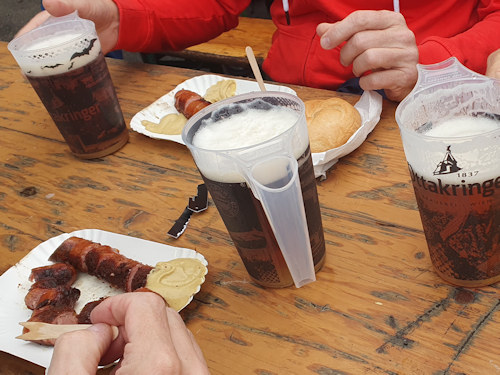
(Pre-match meal: beer and sausage)
Yes.
Traditional fare at an Austrian game of football is a Krügel of beer and a Käsekrainer sausage. No pies that I know of.
Best clubs to watch
Vienna has numerous longstanding football clubs, but try these four tips for the best match day experience.
Wiener Sport-Club (“Sportclub”)
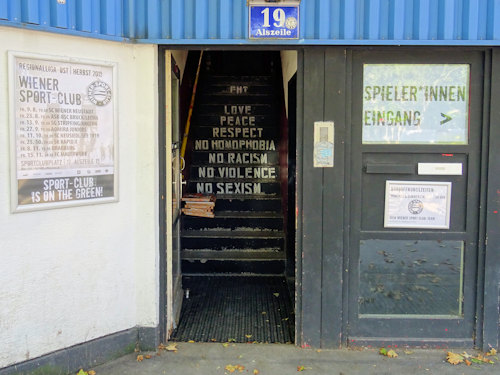
(Sportclub occupy a unique niche in Viennese football)
League: Regionalliga Ost
Typical attendance: Typically somewhere around 1600 fans at the moment, though a derby against Vienna (see below) can fill the stadium with thousands more.
A cult club and fallen giant who hold the record for the heaviest defeat handed to Juventus in Europe, having beaten them 7-0 in the 1958/59 European Cup. (The two clubs have gone in slightly different directions since then.)
Extremely friendly and inclusive atmosphere in the English tradition with fans noted for left-wing leanings and a social conscience. A bigot-free zone. The core supporters group stands on the Friedhofstribüne (the cemetery stand). You’ll find me in the main stand most home games.
The Sport-Club Platz stadium is the oldest in the country where football has been played continuously.
That stadium will be rebuilt from June 2024 to sometime in 2026, so home games will move elsewhere for at least some of that period (likely the nearby training centre on Erdbrustgasse).
Address: Alszeile 19, 1170 Vienna | Website
Travel tip: Take the 43 tram (from Schottentor) or the 2 tram (from, for example, Karlsplatz) to the Dornbach stop.
First Vienna FC 1894 (“Vienna”)
League: Zweite Liga
Typical attendance: Averaging around 2000, though a derby against Sportclub can push the attendance up to over 5000.
The oldest club in Austria and originally established by Englishmen with the support of the Rothschild family.
Another fallen giant (Mario Kempes once played for them), but currently on the way up again after financial problems back in 2017. Vienna gained promotion to the second national league in the 2021/2022 season.
Like Sport-Club, a more friendly and inclusive atmosphere than elsewhere. The two teams are ostensibly great rivals, but, whenever they meet, the match is known as the “Derby of Love”.
The iconic and unusual Hohe Warte stadium has a huge sloping grass hill on one side and once hosted as many as 85,000 spectators.
Address: Klabundgasse 11, 1190 Vienna | Website
Travel tip: Take the U4 subway to Heiligenstadt and walk across (past or through the famous Karl-Marx-Hof)
SK Rapid Wien (“Rapid”)

(The stadium makes it clear who plays here)
League: Bundesliga
Typical attendance: Averaging over 17,000 (at the time of writing)
The best-supported club in the country and one of the traditional big four alongside city rivals, Austria Wien (see below), as well as Sturm Graz and Red Bull Salzburg. Winner of numerous trophies, though the last one was way back in 2008.
The ultras put on quite a show with huge pre-match choreographic displays and a raucous atmosphere, but that becomes a double-edged sword when the team performs below expectations.
The entire crowd always welcomes the last 15 minutes with an ovation to encourage the players. This Rapidviertelstunde (“Rapid quarter hour”) tradition dates back over 100 years.
The new Allianz Stadium, opened in 2016, is a lovely, modern stadium with a capacity of around 28,000.
Purchase a prepaid Rapid Mari€ card at the stadium, which you use to buy drinks and snacks inside; you can top up the amount on the card at numerous locations around the stadium and concourse.
Address: Gerhard-Hanappi-Platz 1, 1140 Vienna | Website
Travel tip: Catch the U4 subway to Hütteldorf and follow the crowds
FK Austria Wien (“Austria”)

(Generali is a large insurance company and stadium sponsor)
League: Bundesliga
Typical attendance: Averaging over 12,000 (at the time of writing)
Vienna’s other big professional club. Not as well supported as Rapid, but with an equally long and proud tradition. Austria were the last team to break the Salzburg hegemony when they won the Bundesliga in 2013.
The club renovated and rebuilt their Generali Arena recently, with the reopening in 2018. So the city now has two very modern Bundesliga stadiums.
As with Rapid, the Austria stadium operates a cashless system inside (use a credit card, debit card or prepaid card bought at the stadium). You can still use cash at the kiosks outside the stadium.
Address: Horrplatz 1, 1100 Vienna | Website
Travel tip: Go to Altes Landgut on the U1 subway to reach the stadium
The national stadium
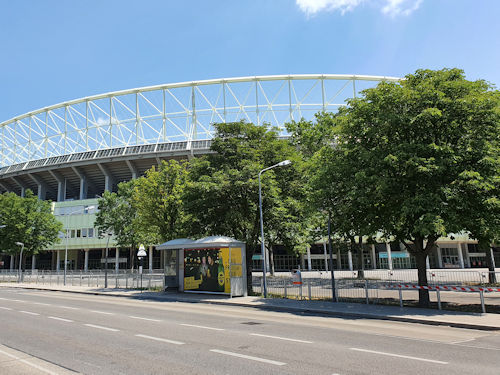
(The country’s largest football ground)
Vienna also hosts Austria’s national football stadium. Not every home international takes place there, but many of them do.
The Ernst Happel Stadion – also known locally as the Praterstadion – has a capacity of around 50,000 and hosted the final of the European Championships in 2008, as well as four Champions League finals (three of those when the competition was the European Cup).
Address: Meiereistraße 7, 1020 Vienna
Travel tip: Take the U2 subway to the Stadion station